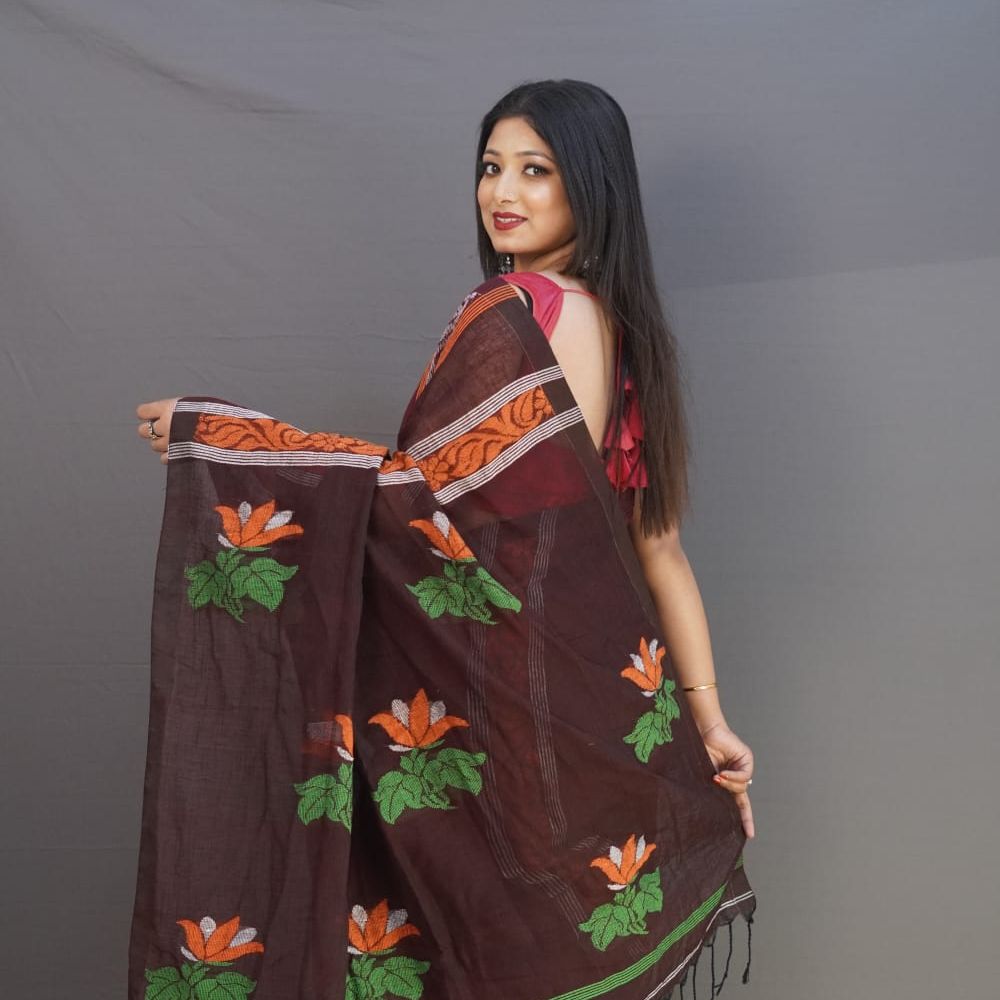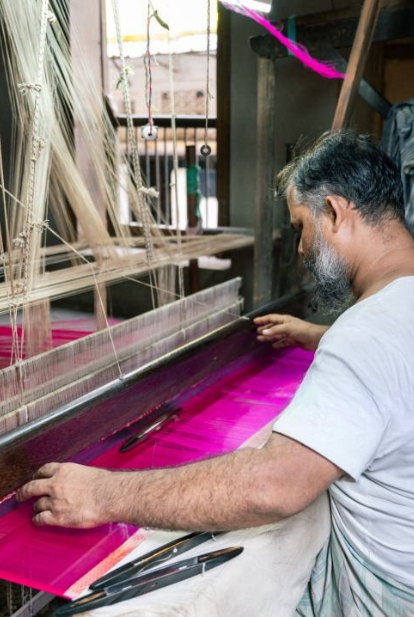Did you ever stop to think about why a white Jamdani saree and red blouse combination always appears so gorgeous?
Why is this time-tested combination so dear to the hearts of fashionistas for generations? It's not merely a matter of looking great—it's one of history, culture, and craftsmanship coming together.
This timeless duo has an ageless appeal that never goes out of style, which is why it remains a go-to for anyone who adores classic yet trendy outfits.
Let's see why such a stunning pairing is still winning hearts and how it balances tradition and contemporary fashion to perfection.
Summary
A white Jamdani saree paired with a red blouse is a timeless and iconic fashion combination that blends tradition with modern style. Originating from the Mughal era, Jamdani sarees are known for their intricate designs and lightweight fabric.
The combination of red and white not only holds cultural significance but also creates a visually appealing contrast that makes it a favorite for various occasions. In this article, we will explore the history, cultural symbolism, styling tips, and how to promote this timeless attire using digital marketing strategies.
Key Points
- Timeless Appeal: The combination of a white Jamdani saree with a red blouse never goes out of style.
- Rich History: Originating from the Mughal period, Jamdani sarees represent elegance and craftsmanship.
- Cultural Symbolism: Red and white colors symbolize purity, new beginnings, and marital bliss.
- Styling Tips: Six unique styling ideas to make the combination look modern and chic.
The Jamdani Legacy: Threads of Royalty and Resilience
A masterpiece of the Mughal period
The Jamdani saree originated in Dhaka, Bangladesh, where it flourished under Mughal patronage in the 16th century.
Known as “woven air muslin” because of its lightweight, transparent fabric, Jamdani was a symbol of opulence.
Emperors like Akbar and Jahangir valued these sarees greatly and often gifted them to royals and dignitaries.
The name of the craft, which is derived from Persian (“jam” for flower, “dani” for vase), reflects its distinctive motifs – delicate floral, vine, and geometric patterns that seem to float on the fabric.
The Art of Weaving Magic
Unlike printed fabrics, Jamdani sarees are crafted using the ‘supplementary warp technique’. The artisans spend several weeks or sometimes months weaving the intricate designs by hand on wooden looms.
Each motif is individually assembled, a process that requires precision and patience. This labor of love earned Jamdani UNESCO Intangible Cultural Heritage status in 2013, cementing its status as a global treasure.
From Decline to Revival
Jamdani weaving almost disappeared during the British colonial period as machine-made fabrics flooded the markets. However, it was revived in the 1970s due to cultural pride and government initiatives.
Today, designers such as Sabyasachi and B.B. Russell are reinventing Jamdani with modern shapes, ensuring its relevance in 21st-century garments.
Red & White: A Palette Steeped in Symbolism
In South Asia, red is the color of passion, good fortune, and marital happiness, while white represents purity and new beginnings. Combined, they create a timeless color combination that has been treasured for centuries. Whether it's a celebratory festival, a wedding ceremony, or a cultural celebration, this combination signifies a harmonious balance of tradition and sophistication.
This combination is very important in Bengali tradition, as brides tend to don white sarees with red borders during pre-wedding ceremonies.
The sharp contrast between the red blouse and white saree adds beauty to elaborate Jamdani patterns, making it a regal and elegant sight. It's a combination that is not only respectful of heritage but also appeals to contemporary fashion sensibilities.
The adaptability of this pair means that it can glide effortlessly from daytime functions to evening parties, rendering it a much-loved favorite among fashionists.
Cultural Echoes
In South Asia, the color red symbolizes auspiciousness, passio,n, and marital bliss, while white represents purity and new beginnings.
Together, they are a staple of weddings, festivals like Durga Puja, and cultural celebrations.
For example, Bengali brides often wear white sarees with red borders for pre-wedding rituals, blending tradition with timeless elegance.
A Universal Contrast
Beyond the symbolism, the visual drama of red and white is unmatched. This stark contrast highlights the intricate weave of the saree, making the wearer stand out in a crowd.
It's a versatile pairing - equally appropriate for a sunny afternoon wedding or a candlelit party.
Styling the Combo: 6 Ways to Make It Your Own
In terms of fashion, it's all about putting your spin on making a look that's unmistakably yours. Whether you're combining patterns, experimenting with texture, or tossing in statement accessories, styling a combo can go from bland to grand. Here, we're going to examine six innovative methods for making any combo your own.
Prepare to turn heads and make a style statement with confidence! Let me know if you’d like more content or specific styling tips!
1) The Eternal Classic
- Blouse: Choose a red silk blouse with a round neck and quarter sleeves. The light golden zari border accentuates the motifs of the saree.
- Jewellery: Pearl choker with ruby pendant or gold earrings.
- Occasion: Perfect for engagement ceremonies or religious events.
Pro tip: Pin the pallu on one shoulder for a royal drape reminiscent of Mughal nobility.
2) Bold & Regal
- Blouse: Dark red velvet blouse with intricate gota patti work or Swarovski studded sleeves.
- Accessories: Polki chandelier earrings and a waistband to wear with the saree.
- Occasion: Wedding reception or celebration.
- Modern twist: Use wine or burgundy instead of traditional red to add depth.
3) Minimalist Chic
- Blouse: A tailored, backless red blouse with a deep neckline. Think satin or crepe for a flowy finish.
- Jewellery: Silver cuffs and a solitaire pendant.
- Footwear: Nude block heels to elongate the silhouette.
- Styling hack: Tie the pallu like a scarf for a contemporary drape.
4) Fusion Fantasy
- Blouse: Pair a red crop top with a high-waist skirt that shows off the Jamdani border.
- Fabric: Contrast texture - Pair the cotton fabric of the saree with a brocade or lace blouse.
- Accessories: Oxidized silver jewelry and leather potli bag.
- Trend alert: Designers like Anita Dongre have popularised this Indo-Western mix on the runway.
5) Traditional Grandeur
- Blouse: Kanjivaram silk blouse with temple motif or Banarasi gold embroidery.
- Jewellery: Multi-layered gold chain, haath phool and maang tika.
- Finishing touch: A Braided, woven fresh jasmine garland.
- Cultural Symbol: Ideal for Durga Puja or Diwali celebrations.
6) Office Elegance
- Blouse: Light brick-red shirt-style blouse with collar and buttons.
- Drape: Fold the pleats neatly inwards for a structured look.
- Accessories: A leather bag and minimal studs.
Why It Works: The subtle patterns of the white damask keep it professional and sophisticated.
Elevating Ethnic Style: The Art of Choosing Indian Accessories
Indian ethnic clothing is all about style, tradition, and bright colors. But the real difference between a good outfit and a great one is how you accessorize it. From show-stopping jewelry items such as jhumkas and chokers to classic favorites such as bangles and anklets, the perfect accessories can make your ethnic outfit look amazing in a split second.
It's not about coordinating colors—it's about merging heritage with your sense of style. In this guide, we’ll dive into the art of choosing Indian accessories that complement your outfit, enhance your style, and make a lasting impression.
Jewellery
- Neckline matters: High-neck blouses look good with long ‘ranjha’ earrings, while sweetheart necklines shine with chokers.
- Mixed metals: feel free to use rose gold or oxidized silver for a modern touch.
Bags
- Daytime: Woven jute clutches for a rustic charm.
- Evening: Embroidered ‘Potli’ or sequined minaudiere.
Footwear
- Ethnic Attraction: Kolhapuri Sandals or ‘Mojaris’ with metallic thread.
- Modern Style: Transparent PVC heels or ankle boots for a fusion look.
Hair and Makeup
- Hair: Low buns with tendrils framing the face, or beach waves for a relaxed vibe.
- Makeup: Bold red lips to match the blouse, or smoky eyes for evening drama.
Confidence: Your Secret Styling Weapon
A jamdani saree requires elegance. Practice the “queen’s walk” – slow, measured steps that open the pleats.
Posture is important: shoulders back, pallu draped elegantly.
As designer Sabyasachi says, "Clothes are a reflection of your self-esteem. Wear them as if they are your own.”
Beyond Fashion: The Ethical Choice
Choosing Weavehand handlooms directly supports the Jamdani artisan communities. We are committed to offering ethically crafted pieces that not only empower the weavers but also preserve their invaluable heritage.
Conclusion
The iconic white jamdani and red blouse are the foundation of your expression. Whether you're into classic grace or contemporary flair, let your personality shine.
This outfit is a legacy you are carrying forward, a story that is yours. Wear it with confidence, accessorize thoughtfully, and redefine tradition with your unique style.



